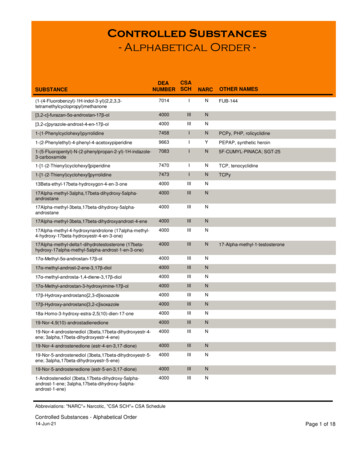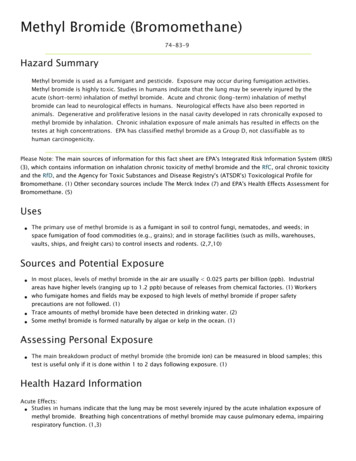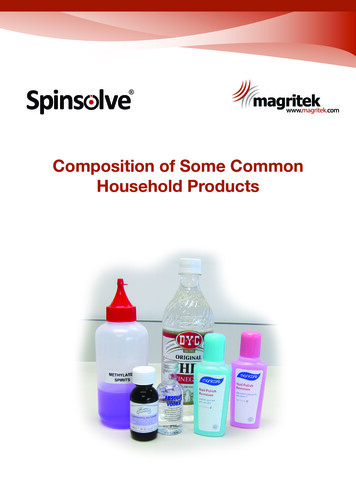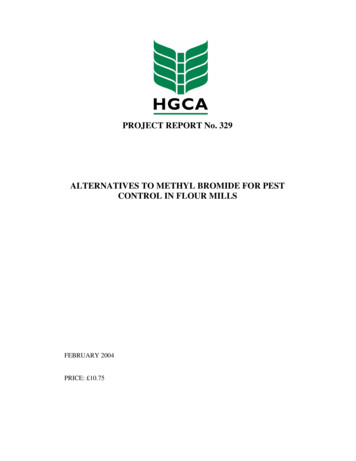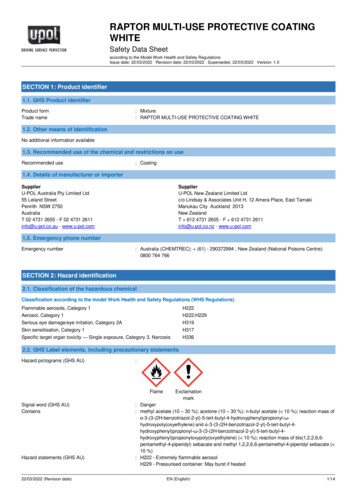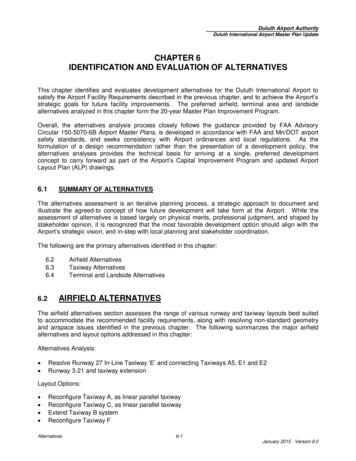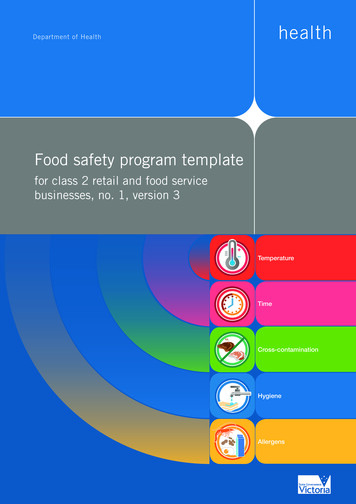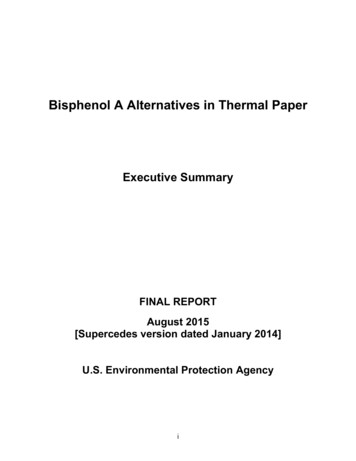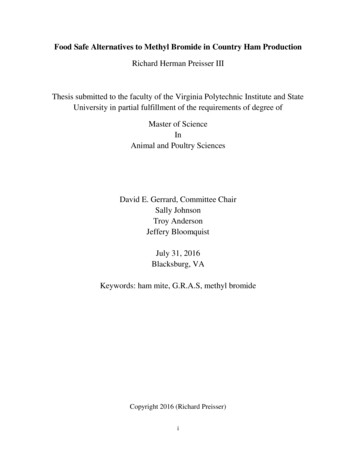
Transcription
Food Safe Alternatives to Methyl Bromide in Country Ham ProductionRichard Herman Preisser IIIThesis submitted to the faculty of the Virginia Polytechnic Institute and StateUniversity in partial fulfillment of the requirements of degree ofMaster of ScienceInAnimal and Poultry SciencesDavid E. Gerrard, Committee ChairSally JohnsonTroy AndersonJeffery BloomquistJuly 31, 2016Blacksburg, VAKeywords: ham mite, G.R.A.S, methyl bromideCopyright 2016 (Richard Preisser)i
AbstractDry cured meat production is a costly and long term investment for producers. Ham mites(Tyrophagus putrescentiae) are a common pest of dry cured products and cause devastatingeffects, potentially nullifying producers’ investments due to loss of salable product, as well asregulatory concerns. Methyl bromide, a chemical fumigant used to control mite populations, isdamaging to stratospheric ozone and will no longer be available. Presently, no alternative controlmeasure has been approved to combat the ham mite; therefore, it is essential to identify potentialalternatives. Interest in safe alternatives to control arthropod pest populations is gainingmomentum, and garlic (Allium sativum) has been used to control other arthropod speciesincluding the northern fowl mite, mosquitos, and aphids. We chose to explore the efficacy ofgarlic juice in controlling T. putrescentiae. Using a choice test design, approximately 65% of theinoculated mites colonized on the control ham cubes, while no mites remained on garlic juicedipped cubes. Garlic was ineffective when examined for volatile efficacy, but was effective indirect contact assays. However, as garlic juice was aged and diluted, efficacy was reduced evenafter treatments with antioxidants, metal chelators, and pH neutralization. In total, garlic juiceacted as a short term repellent and showed efficacy in contact models, but application is timesensitive due to variable enzymatic degradation.ii
DedicationThis could not have happened without those who had faith in me and helped me reach my goals.However, this would not have happened without those who didn’t, and attempted to impede myprogress along the way. To both groups, thanks for the motivation.iii
AcknowledgementsGod, family, and friends.Many thanks toJesus Christ, my savior: You know more than anybody how close I was to losing my religionthrough this degree. I thank you for keeping me strong faithful throughout the process. I pray youcontinue building me into the man and servant that you desire. I thank you for the manyblessings that you have bestowed upon Afton and myself. I promise we will do everything in ourpower to live our lives for you and only you.Dr. Dave Gerrard, my advisor: I have had mentors that allowed me to just think inside the boxand I have had many others that pushed me to think outside the box. However, you are the firstto make me build my own box just so I could think both inside and outside of it, all the whilesimultaneously flipping it inside out. Although your style is not the easiest, it forced me tobecome a better scientist and definitely helped prepare me for the real world. My time workingwith you has made me realize that the most rewarding destinations are not always at the end ofthe easiest path. For that, I thank you.Dr. Sally Johnson: for all your support, advice, and patience.Dr. Jeff Bloomquist: for your insight on pest problems and entomological expertise.Dr. Judy Mollet: for helping me get the entomology ball rolling.iv
Dr. Troy Anderson: for lending me a helping hand, knowledge, equipment, and your graduatestudents all in an effort to help control the ham mite. Without you and your lab, this would nothave been possible.Dr. Tom Phillips: for all mites, diet, and experimental design expertise.Philene Vu: for your hands on support in trying to turn this meat head into an entomologist. Iapologize for my ignorance and greatly appreciate your expertise in mite experimental design.To all of my labmates: Sulaiman Matarneh, Eric England, Kristen Stufft, Bly Patterson, andJordan Wicks. You all have become like family to me over the past two years. While we areprobably the most diverse and dysfunctional family I have ever known, somehow we havemanaged to function together through it all.Skylar Workman, my undergraduate volunteer: while our time together was short, yourwillingness to help was pinnacle in completion of this project.Patricia Williams: words cannot express how much I appreciate everything over the years.Afton Olivia Preisser, my wife: it takes a very special kind of woman to put up with somebodylike me. I never would have thought that I would find one willing yet eager to deal with myways. I could not have gotten through this without you and your daily support. God wasdefinitely looking out for me when he sat us both down in the same intro class.My family: for all of the love and support during this experience. Mom and Paul: Even thoughyou two may not have always understood or agreed with me becoming a “professional student”,you were always there for me. I would not have made it here without either of you.Virginia Pesticide Council: without your financial backing, this wouldn’t have happened.v
Table of ContentsAbstract .iiDedication . iiiAcknowledgements .ivTable of Contents .viList of Figures .viiList of Tables .ixChapter 1. Introduction and Literature Review-Country Ham Industry .1Introduction .1Regulatory Development .1Industry Overview .2History . . 2Current Demographics. 3Production Process . .4Arthropod Pest . 5Ham Mite . .7Pest Management . .9Alternative Control . .10GRAS . . .15Conclusions . . .20References 21Chapter 2. The acaricidal effects of fresh garlic juice on adult tyrophagusputrescentiae 26Abstract .27Introduction 28Materials and Methods .27Results and Discussion .33Conclusions 39References .49Chapter 3. Future Studies .51vi
List of FiguresChapter 2Figure 1. Two-choice selectivity design offered mites free will between two ham cubes, onecoated in fresh garlic juice (FGJ) and the other distilled water (-)control . .40Figure 2. FGJ (200 µl) direct contact exposure in comparison to equal volume ( ) linaloolcontrol and (-) distilled water and no treatment control(NT) 41Figure 3. FGJ volatile effectiveness in comparison to equal volume ( ) linalool control and (-) notreatment control (NT) . .42Figure 4. Garlic Juice Functionality Extension .48vii
List of TablesChapter 2Table 1. FGJ concentration titrations and supplementary time count for mortality ratedifferences. . 43Table 2. Aged 8-hour garlic juice concentration titrations and supplementary time count formortality rate differences. .44Table 3. Aged 24-hour garlic juice concentration titrations and supplementary time count formortality rate differences. .45Table 4. Aged 48-hour garlic juice concentration titrations and supplementary time count formortality rate differences. . .46Table 5. Aged 72-hour garlic juice concentration titrations and supplementary time count formortality rate differences. .47viii
Chapter 1. Introduction and Literature Review of Country Ham IndustryIntroductionTyrophagus putrescentiae, more commonly known as the ham or cheese mite, isa common pest of dry cured meat products. These parasites cause food safety concerns in theform of allergens and are difficult to control due to the vulnerability of country ham duringvarious stages of production. For years, methyl bromide has been used as an effective fumigantfor controlling ham mites on dry-cured hams. Recently, the industry has faced the loss of thisvaluable chemical. Due to damaging effects on the stratospheric ozone layer, methyl bromide isbeing eliminated in accordance to the Montreal Protocol’s Clean Air Act. Therefore, effectivemethyl bromide replacements are necessary so producers can continue to sell safe andwholesome country ham products in the foreseeable future. Current alternatives include: otherfumigants, as well as food-safe coatings and compounds.Regulatory DevelopmentMethyl bromide has been the gold-standard fumigant in the ham industry for well over40 years (Sekhon et al., 2010). Applied as a fumigant, methyl bromide is used against multiplepests ranging from fungi to rodents; thus, is considered a broad spectrum pesticide (Sekhon et al.,2010). It has also been implemented in a variety of commodities ranging from vegetables toarboriculture (Noling & Becker, 1994). Regardless of methyl bromide effectiveness and itsversatility, it is one of the leading contributors to ozone depletion, making safe alternativesessential (Marriott & Schilling, 2004).1
The Clean Air Act of the Montreal Protocol established new regulations governing thefuture of methyl bromide, which is now considered a Class I ozone depleting substance (EPA,2007). At present, the cost of methyl bromide has reached a point where it is no longer readilyavailable. Since 1999, the purchase price of methyl bromide has increased from 2.50/lb. to 20/lb. (Osteen, 2003). It is unknown when methyl bromide usage will be banned completely,but it is currently the only chemical available for effective control of ham mites (EPA, 2010).Therefore, there is some urgency in identifying alternatives to methyl bromide.Country Ham Industry OverviewHistoryAs with many historical facts, there are discrepancies in the origins of the salting processas a food preservation practice. Mesopotamians are thought to be the first culture to use saltingas a form of preservation, which was likely discovered by necessity (Nummer & Andress, 2002).Salt curing is a process used on a number of food items, including but not restricted to fish, redmeats and vegetables as early as 3000 B.C.E. (Pariza, 1997). Cato, a Roman author, alsodocumented the importance of using salt to preserve food around 234-149 B.C.E. (Nummer &Andress, 2002). Regardless of the inventor, the process of salting food has been around for alongtime as a means to preserve food against deterioration and spoilage.Current DemographicsSalt curing of meats has evolved from being an essential means of preservation to arelatively small and diverse niche industry that produces a wide variety of products with highlyvariable final characteristics. In fact, salt cured meats are mainly considered a delicacy. Themajority of the hams produced across the globe originate from the “ham belt”, which includes2
portions of Europe, China, and North America mainly because these countries provide the bestclimate and conditions for salt cured ham production (Tobergte & Curtis, 2013).The process of salt curing is often generalized to hams, but other products are cured usingsalt, including fish, duck breast, spalla (pork shoulder), pancetta (pork belly), lardo (pork fat),capocollo (pork neck shoulder junction), sopresatta and other sausages. In Asia, there are twomajor types of ham, Jinhua and Yunnan hams (Tobergte & Curtis, 2013). Common Spanish andEuropean hams include: the Westphalian (Germany), Black Forest (Germany), Prosciutto/Parma(Italy), Culatello, Jamon Iberico (Spain), and Jamon Serrano (Spain) (Tobergte & Curtis, 2013).North America-specific, dry-cured hams (country hams) are most often produced inVirginia, North Carolina, West Virginia, Kentucky, Tennessee, Georgia, and Missouri (Rentfrowet al., 2008). However, there are two main styles produced, the South East (SE) Virginia-style orthe South West (SW) Virginia-style (Graham et al., 2012). Originating around Smithfield,Virginia, the SE style is most commonly fabricated and consumed, indicative of the Smithfieldham. The main difference between the two hams is the SE hams includes a smoke flavor and theSW version generally does not. The SW ham usually involves applying a sucrose-based coatinginstead of smoking. This often consists of a sweet liquid mixed with a spice, most likely sometype of honey or molasses base. While both have their advantages and disadvantages, it isimportant to understand the differences in initial processing, as it plays a key role in how andwhy ham mite problems can occur.Production ProcessHam production practices create an ideal environment for ham mites and other pests.Indeed, certain aspects of production are essential for quality ham production. Even so, however,particular segments of the process promote ham mite survival and growth. First, the process is3
very long, at least relative to other processed meats procedures, sometimes spanning overmultiple years. During that time, there are many variables that can be potentially deleterious tothe process. Common examples include losses associated with pests, inadequate cure uptake,ham sour, and other unforeseen issues related to storage time. This additional time and overheadis realized in the cost of the product. Some specialized hams such as Iberico Prosciutto forexample, can reach 1500 U.S. dollars per ham or about 150/lb. Although typical country hamsare less valuable, the potential losses to producers are nonetheless severe.All meat can be cured. For brevity, hams will be used as an example and general term.First, fresh raw products must be sourced (Grahm et al., 2012). Traditionally, hams for drycuring weigh from 6.8 to 11.3 kilograms. Salting is key to ensuring a safe and wholesomeproduct. Hams need to lose a minimum of 18% of their green or fresh weight and contain 4%salt in the final product (Rentfrow et al., 2012; Tobergte & Curtis, 2013). The salt mixture varieswith producer and consists of a mixture of salt, sugar, spices, and cure. The generalrecommendation is an 8-2-2 mixture, consisting of 8 lbs (3.6 kg) salt, 2 lbs (0.9 kg) sugar, and 2oz (56.7 g) cure for every 100 pounds of green product, respectively (Grahm et al., 2012).Country style hams are generally salted for about 1.5 - 2 days per pound green weight in a cooledenvironment (Voltz and Harvell, 1999; USDA, 1999).The next step is the equalization process. At this point, hams are equilibrated to about 12.2 to -6.6 ºC warmer environment so salt can evenly distribute throughout (Tobergte & Curtis,2013). It is critical the salt reaches all portions of the ham equally or the entire ham will besubject to spoilage.After equalization, hams are generally cold smoked to ensure the internal temp residesbelow 32.22º C (Grahm et al., 2012). If the temperature isn’t properly controlled, microbial4
growth occurs and product quality impacted. It is also important to note that this process is not acook step, and ‘smoked’ doesn’t imply it is ready to eat, or RTE. Many people don’t realize thatmost hams require cooking prior to consumption, even though they are often shelf-stable.The final step before sale is the curing or “summer sweat” step (Tobergte & Curtis,2013). It is during this step that the ham gets its unique flavor and quality. Hams are stored attemperatures that simulate a warm summer day, which historically is considered optimal curingconditions. Smaller facilities generally use ambient air temperatures, but larger operationsproduce hams year around and have climate controlled rooms allowing for relative humidity andtemperature regulation. It is ideal to have room around 65% relative humidity, as it is importantto final product quality (Rentfrow et al., 2012). The cure process can range from a few months,to a few years depending on the product quality specifications. The extended process and relativehumidity utilized in country ham production, especially the summer sweat, provide an idealenvironment for ham mite infestations. Ham spacing, wooden equipment and rooms exacerbatethe problem.Arthropod PestsOne of biggest issues in country ham production is the presence of pests in or on theproduct. Hams houses provide the environment and necessary food source to supply arthropodinfestations that can continue undetected for long periods of time. Unfortunately, the age andstyle of many traditional ham houses lends additional opportunity to pest problems. When thesefactors are combined with high traffic and annual use of most ham houses, pest problems arise.Other Stored Meat PestsThe larder beetle (Dermestes lardarius L.), red legged ham beetle (Necrobia rufipes), andskipper (Piophila casei) are common pests of dry cured meat products (Grahm et al., 2012).5
Some cause considerable damage, but in ways unlike the ham mite. Moreover, control methodsdiffer greatly from those used against ham mites. Regardless, it is important to effectivelydifferentiate the following pest from the ham mite.Cheese SkipperThe skipper is an insect most prone to be a problem with hams stored outside, but canexist in the most modern ham houses. The skipper gets its name from the hopping action of thelarvae (Grahm et al., 2012). The larvae tunnel through hams, which makes the interior vulnerableto other insects or spoilage bacteria. Skipper infestation is easily observed by a gooey-liketexture on the surface of hams. The skipper has two wings and are 1/3 the size of a typical housefly and multiply very rapidly. Hams with skippers should be heavily trimmed around tunnels ordiscarded (Grahm et al., 2012).Larder BeetleLarder beetles are yellow/brown in color and are usually 8.5 mm (Grahm et al., 2012).The larvae feed underneath the surface of the ham which prevents ham spoilage, but spots wherelarder beetles are found should be removed.Red-Legged Ham BeetleThe Red-legged ham beetle larvae are a dark red and about 8.46 mm long. Adult beetlesfeed on the ham surface and are bluish green in color and measure about 6.35 mm long(Simmons & Ellington, 1925). Like the skipper, they tunnel through the meat; however, theirtunnels serve only to dry the meat and damage resulting from a beetle infestation are simplytrimmed and properly cooked before consumption (Grahm et al., 2012).All of the aforementioned arthropods are serious pests of country ham and the damagecaused by each is different than the ham mite.6
Ham MiteMite Impact on the IndustryHam mites are a significant problem to the industry, not because they degrade theproduction, but because they are considered a zero tolerance due to the allergenic nature of themite. Mite presence causes surface damage and can periodically shut down an operation due tocurrent regulatory tolerances (USDA, 1999). Interest in alternative strategies to control theseacari has been proposed by integrated management systems that include country ham IPM andmethyl bromide replacement options (Zhao et al., 2016).Commonly referred to as “barn allergy”, storage mites produce numerous allergens thatcan affect a wide range of people and pet species (Cuthbert et al., 1979). Acari species includingTyrophagus, commonly cause dermatitis and respiratory issues through the allergens they shed inagriculture industries (Wraith et al., 1979). Under certain cases, mite allergens can causesystemic anaphylaxis, making their presence highly regulated (Matsumoto et al., 1996).A study was conducted on thirty-four U.S. ham producers to determine the prevalence ofham mites (Rentfrow et al., 2008). Of those producers surveyed, twenty-five plants hadproblems with ham mites and fifteen of which had problems after 6-months of curing. Curiously,ten of the producers had mite problems before the product had cured 6-months. This informationshows the prevalence of mites in the industry, and suggests mites are both a long- and short-termproblem.Mite Biology7
Ham mite (Tyrophagus putrescentiae) are common pests in stored meats, cheeses, flour,grains, and animal feed (Rodriguez & Rodriguez, 1987; Chambers, 2002). Because of their size,ham mites are often mistaken for dust mites, but they are actually mold mites (Mueller et al.,1997), and can readily infest any product with adequate fat, protein, or moisture content(Mueller et al., 1997).Belonging to the acaridae family, mites are near microscopic (1/2 mm) in size and whitecolored and tend to reflect the color of food they consume (Zhao et al., 2016). Ham mitesgenerally appear as off-white particles on the ham surface during the curing process. They aremore noticeable as the colony becomes established because of the residual exoskeletons andnewly formed, developing mites. A distinct odor is associated with mite infestations, sometimesdescribed as sweet or minty odor and experienced producers can smell infestations prior to beingvisible to the naked eye (Townsend, 2008).Under optimal conditions mites live about 31 days, and as temperatures decrease, themite life cycle reacts inversely (Sass, 2006; Mueller et al., 1997). Inactive mites can withstandtemperatures down to 0 ºC, but do not development below 10 ºC (Mueller et al., 1997). Eachfemale has the potential to lay approximately 800 eggs in her lifetime under ideal conditions(Townsend, 2008). Mites prefer a warm moist environment and tend to be more productive onless desiccated product surfaces. The ham mite life-cycle consists of the egg, larva, nymph, andadult (Townsend, 2008).Dry cured products are formed under conditions of around 75 ̊ F (23.8 ̊ C) and 65%humidity depending on the production system (Rentfrow et al., 2012). When the ham begins theessential cure or summer sweat process, moisture is released from lean surfaces providing a8
moist and nutrient rich food source for the ham mite. This moisture loss periodically softens thesurface and causes mold growth and allows mites to flourish.Pest ManagementIntegrated Pest ManagementBecause dry cured ham production and optimal mite growth share similar optimumconditions, a great deal of work has been put into altering or improving common productionpractices in an effort to reduce mite occurrence. Integrated pest management (IPM) is asystematic or stepwise method for controlling pests that involves the use of multiple practicesthat help reduce a pest population. IPM is strategic accumulation of methods that is utilized inmany pest management protocols today. IPM practices are configured differently for all pests,yet have the common goal of controlling pest populations.Rentfrow et al., (2015) provided a comprehensive review of management practices thathelp prevent the occurrence of ham mites. Prevention for ham mites begin with the exterior ofthe operation. Producers should seal off access areas or inhabitable spaces that mites may use,minimize plant traffic, and enforce biosecurity measures at all times. For non-inspectedoperations, suitable insecticides may be used to treat empty rooms (Rentfrow et al., 2015).Alteration of humidity and temperature help control mite development (Barker, 1966). Propersanitation begins with removing debris, weeds, and product trimmings from the ham housebecause it eliminates inhabitable vectors (Rentfrow et al., 2015). Monitoring mite populations isconducted using visual and olfactory inspections of the ham the storage area. Traps are alsoavailable and can be utilized for early mite detection.9
These procedures can aid in pest reduction when combined with other measures such aschemical control. Alternative fumigants such as phosphine and sulfuryl fluoride (SF) have beenused to further control pest populations. However, neither are ideal because both are corrosiveand deleterious to the facility and fail to control egg stages (sulfuryl fluoride).Alternative Fumigant ControlPhosphinePhosphine fumigation has been studied as a potential substitute for methyl bromide in thecountry ham industry because of its successes in other stored commodities (Sekhon et al., 2010).Phosphine is easily implemented, relatively inexpensive, and delivers a strong knockdown(Zuryn et al., 2008). However, phosphine fumigation has negative side effects including: pestresistance, flammability, and corrosive to metals in ham houses (Price and Mills, 1988; Zettler, etal., 1989; Brigham, 1998).Phosphine is extremely potent for pests utilizing oxidative respiration, but less so to thosecapable of functioning in low oxygen conditions (Sekhon et al., 2010). This occurs becausephosphine alters oxygen metabolism, forming deleterious oxyradicals, which in turn altersrequired enzymatic function leading to metabolic disorders (Zuryn et al., 2008). Because of thesequalities, phosphine is effective in controlling multiple insect growth stages (Bell, 1976)No dedicated legal limit is set for residual phosphine, but based on other industries it isprobably very close to 0.01 ppm (Sekhon et al., 2010). Based on this limit, phosphine can befumigated at concentrations up to 1000 ppm and still be below the legal limit for safeconsumption with minimal sensory aromatic quality impacts (Sekhon et al., 2010). At these10
levels, residual levels are below the 0.01 ppm limit and effective on all mite life stages (Schillinget al., 2010).Sulfuryl fluorideSulfuryl fluoride is currently under investigation for ham mite control (Sekhon et al.,2010). The same study tested various fumigation concentrations and volatile flavorconcentrations of sulfuryl fluoride and fluoride ranging from (0, 12, 24, 36 and 72 mg/L).Results show that both fluoride and SF concentrations became greater as fumigant concentrationincreases, but the legal limits of 20 and 0.01 ppm were never crossed. Aromatic differences wereminimal, but product oxidation compounds were increased in the highest fumigationconcentration. In total, there were minimal aroma/flavor differences in hams fumigated with thefour lowest concentrations, and no safety concerns for consumption were noted. Further, SF isunable to control egg stages even after multiple applications. This makes the use of SF a poorsubstitute for methyl bromide (Sekhon et al., 2010; Zhao et al., 2016).Due to problems associated with chemical alternatives and consumer trends, interest insafer control measures is expanding. Currently, alternatives include biological control, physicalmodification, ozone fumigation, CO2 fumigation, food grade coatings, and botanical insecticides.Alternative ControlBiological ControlBiological control measures are a useful tool against pest problems, especially in IPM.(Cheyletus eruditus) is a common mite predator that has been utilized in stored grain applications(Zdárková, 1998); however, control abilities vary with environmental conditions and relative11
prey proportions (Lemus, 2014; Zdárková, 1998). Unfortunately, due to differences inproduction practices and biological requirements, C. eruditus was less effective in dry cured hamproduction than in the grain industry (Escudero & López, 2001).Physical MethodsTemperature reduction and irradiation have been proposed to combat the ham mite asthey have been applied in many other IPM protocols (Zhao et al., 2016). Ham mite egg mortalityoccurs at temperatures of -15º C and -5º C after 24 h and 24 d time (Boczek, 1991). However,Arnau & Guerrero, (1994) were unable to produce egg mortality after 48 h at -25º C.Unfortunately, extreme temperature reduction can be deleterious to ham quality and attempts touse high heat treatments have led to safety concerns (Zhao et al., 2016). In total, conflictingresults, safety concerns, and quality impediments make temperature modification impractical inthe control of ham mites. Other practices such as ultraviolet-c irradiation have been attemptedand proven effective on ham mites without quality deterioration. However, the cost associatedwith necessary equipment and implementation is prohibitive for most producers (Zhao et al.,2016).Ozone ModificationIn in vitro studies, application of 175 ppm ozone concentration for 48 h produced 100%mortality of ham mite at all life stages (Sekhon et al., 2010). Unfortunately, the penetrativeproperties of ozone are minimal, meaning it may not be effective on pests residing in fissuresbelow the ham surface. Additionally, ozone increased ham oxidation, but not to consumerdetectable levels. Further research in full scale operations is necessary before considered a viable12
alternative. Ozone is highly corrosive to equipment and may have some difficulties in beingadapted, if proven effective.CO2 FumigationSchilling et al. (2010) examined the efficacy of atmospheric modification through CO2gas, a common ingredient in modified atmosphere packaging. After a 144 hr exposure, at 60%CO2, complete mortality occurred, regardless of life stages. Even so, however, a 144 hrfumigation protocol is industrially unfeasible and impractical given this would greatly reduceplant productivity. Furthermore, safety concerns arise as high concentration CO2 fumigation canbe dangerous even to surrounding organisms.Food Grade CoatingsIn the Spanish dry cured ham industry, it is a common practice to coat products with alard-based paste to help protect hams against a number of storage-related issues (García, 2004).Food grade coatings are also utilized in other industries such as fruits, vegetables, and meatproducts (Zhao et al., 2016). Recently, Zhao et al., (2016)
Interest in safe alternatives to control arthropod pest populations is gaining momentum, and garlic (Allium sativum) has been used to control other arthropod species . (Noling & Becker, 1994). Regardless of methyl bromide effectiveness and its versatility, it is one of the leading contributors to ozone depletion, making safe alternatives .
